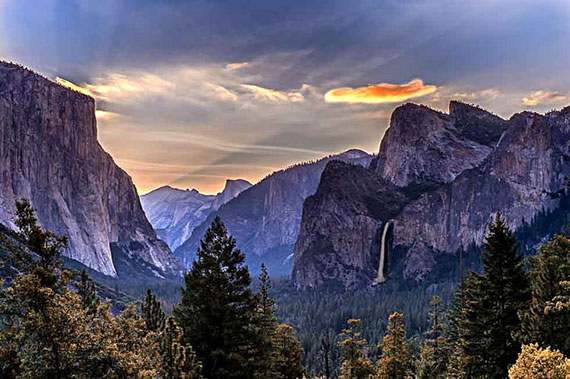Landscape photography relies a lot on good lighting. Let me rephrase that… it relies on great lighting. Great lighting can be found if you know where to look, and when.

Photo by Ajay Goel
Understanding the balance of light—or light ratio—between foreground and background areas will put you on the road to better landscape photography. The background usually means the sky, and the foreground is usually the subject of the photograph, e.g., a hill, building, or lake.
For the sake of simplicity, let’s assume the subject is a hill.
It’s 6am, and you’ve chosen a nice spot where the sun will rise behind you and your camera. You set up your sturdy tripod, engage the mirror lock-up, and wait. The first rays of the sun slowly breaks out above the horizon and illuminates the peak first, because that’s the highest point. The sunlight gradually illuminates the whole hill as the sun rises higher above the horizon.
By 8am the sun would be high enough to illuminate the hill quite completely, thereby giving you a 50:50 ratio of light between the hill and sky. Imagine for a moment that you’re shooting from the opposite direction, with the sun facing you, shining at you from behind the hill. The lighting ratio would drastically change to about 5:95 (hill:sky) because there would be very little light illuminating the hill, but a lot of light in the sky—the sun would be shining directly into your lens. This is evident in photographs of scenery with a white sky and a dark landscape. Or silhouette photos.
Now that we know which direction NOT to shoot from, we will try shooting with the sun to our left. This will create cross lighting which can be very attractive. Cross lighting is used in people photography in the form of off-camera flash. Now you know why your built-in flash rarely gives flattering portraits!
At noon the sun will be directly above almost everything in your scene, giving it a 20:80 ratio. This is because the sky will almost always be brighter than your hill at this hour, especially in humid tropical climates like Malaysia. In dry climates you may still get a 50:50 ratio at this hour. If storm clouds start gathering behind the hill, the dark clouds will create a 60:40 (hill:sky) ratio if there are openings in the cloud cover that allow the sun to illuminate the hill. This can yield beautiful landscape photography because the sunlit foreground can really stand out from the background of dark clouds.
Shooting at the right time and direction will make a dramatic difference to your landscape photography. Understanding the balance of light and what affects this balance will bring your photography to the next level.
About the Author:
Andy Lim (SimpleSLR) runs a profitable photography business that spans wedding photography, commercial photography and conducting photography workshops.
Like This Article?
Don't Miss The Next One!
Join over 100,000 photographers of all experience levels who receive our free photography tips and articles to stay current:






Guys, here’s an updated link for my diagram on lighting ratios for landscapes:
http://www.goodphotography.info/light-ratios-for-landscapes
I feel like this is one of the trickiest aspects of landscape photography because the perfect lighting could change any minute and can make or break a photo. Good article and topic.
Hi Jan, this article was from my original article at http://www.goodphotography.info/intermediate/light-ratios-for-landscapes
You can find the diagram on my site.
Andy
“Pay attention to the bar graphs on the right side of the diagram below. They show the balance of light (or lighting ratio) between the foreground (hill) and background (sky) within a scene.”
I can’t seem to find a bar graph or a diagram. Do I need new glasses?